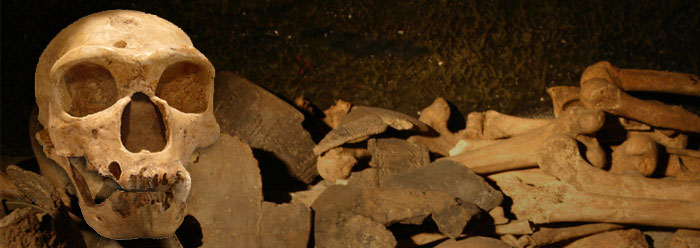Japanese and European anthropologists recently published a study they conducted on the remains of Neanderthal children. Neanderthal skeletons resemble those of modern humans but are characterized by larger heads, thicker brow ridges, and heavier bones. The researchers compared reconstructions of a newborn Neanderthal with the skeletons of infant Neanderthals to gauge the growth rate of their heads. They found that “Neanderthal brain size at birth was similar to that in recent Homo sapiens.”1 They also estimated that the growth rate of Neanderthal baby skulls was as slow as, or slower than, those of modern human babies.
This research confirms several aspects of the creation model. The fact that cranial development in modern humans closely matches that of Neanderthals, but is markedly dissimilar to that of chimpanzees, supports the idea that Neanderthals represent an extinct variant of humans, not an earlier branch on an evolutionary tree.2 As summarized in the study published in Proceedings of the National Academy of Sciences, “From birth to adulthood, the human brain expands by a factor of 3.3, compared with 2.5 in chimpanzees.”1 Humans don’t share ancestry with apes, but were instead uniquely formed.
The study results also support a particular biblical view of Neanderthal man, as described by orthodontist Jack Cuozzo in his book Buried Alive.3 Cuozzo proposed that Neanderthals may have been some of the people who lived immediately following the Flood of Noah, whom the Bible records as having lived much longer than humans do today. For example, Abraham, who lived 302 years after the Flood began, died at age 175. Dr. Cuozzo documented that as time went on during the decades of his medical practice, the development of cranial and physical maturity in his patients occurred at increasingly younger ages.
In other words, humans appear to be aging faster now than they did earlier in their history. Extrapolating this trend, the ancients would have matured at a much slower rate. Also, certain bones, including the frontal bone’s brow ridge, continue to grow throughout a person’s lifetime. If ancient people lived longer, certain of their bones would have grown beyond the extent seen in modern man with his shorter lifespan. The team of researchers confirmed, “[I]t is likely that Neanderthal life history was similarly slow, or even slower-paced, than in recent Homo sapiens.”2
The erroneous view that Neanderthals represented a gorilla-like offshoot in the chain of modern humans’ supposed evolutionary past was propagated by Marcellin Boule in a series of articles that appeared between 1911 and 1913 in Annales de Paleontologie.4 This view was later refuted, but it remained vividly illustrated in museums and textbooks for decades and still lingers in our culture. Neanderthal skeletons have been found that included certain features of modern humans,5 and some Neanderthals were buried ritualistically, even with tools and other artifacts. These confirm that Neanderthals were fully human, not partly human. Again, we see more reason for confidence in the fidelity of the Word of God, which describes man as His unique creation, placed on earth to know Him.6
References
- Ponce de Leon, M. S. et al. 2008. Neanderthal brain size at birth provides insights into the evolution of human life history. Proceedings of the National Academy of Sciences. 105 (37): 13764-13768
- Morris, J. 1997. Is Neanderthal in Our Family Tree? Acts & Facts. 26 (9). See also Phillips, D. 2000. Neanderthals Are Still Human! Acts & Facts. 29 (5).
- Cuozzo, J. 1998. Buried Alive. Green Forest, AR: Master Books.
- Lubenow, M. 2004. Bones of Contention. Grand Rapids, MI: Baker Books, 53.
- Duarte, C. et al. 1999. The early Upper Paleolithic human skeleton from the Abrigo do Lagar Velho (Portugal) and modern human emergence in Iberia. Proceedings of the National Academy of Sciences. 96 (13): 7604-7609.
- John 14:7.
* Mr. Thomas is Science Writer.
Article posted on September 26, 2008.














